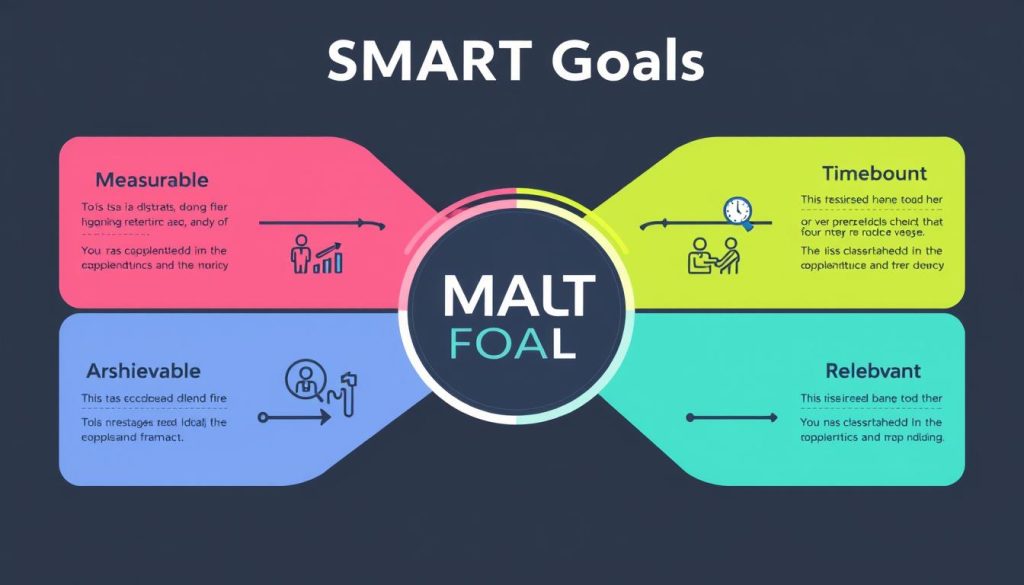Achieving Success: Tips for Setting Achievable Goals
Setting achievable goals is key to my success. A good goal-setting strategy helps me know what I really want. Studies show that specific and challenging goals boost my performance and motivation.
By using SMART goals, I set myself up for success. This means my goals are Specific, Measurable, Achievable, Relevant, and Time-Bound.
Writing down my goals makes me more likely to achieve them, says psychologist Gail Matthews. Sharing my goals with others helps me stay focused. Breaking down big goals into smaller steps and setting timelines makes my goals clearer and more achievable.
What Is Goal Setting?
Goal setting is key in my journey to reach personal and professional dreams. The goal setting definition is about setting clear goals and making a plan to achieve them. It helps me stay focused and track my progress.
By setting both long-term and short-term goals, I create a roadmap. This roadmap matches my priorities and values.
Research shows that setting clear goals boosts success. People who plan their actions have a 2x to 3x success rate. This shows the benefits of goal setting in driving progress.
Using habit stacking can improve my goal achievement. It connects new goals to my daily routines. This keeps me consistent and helps me stick to my goals.
It’s also important to set both upper and lower bounds for my goals. This ensures I have clear limits while aiming for my targets.

The Importance of Setting Achievable Goals
Setting achievable goals is key to my personal and professional growth. Clear goals give me focus and direction. This motivates me to act and make progress.
When I reach my goals, my confidence and self-esteem grow. This makes me believe more in my abilities.
To get the most from my goals, I make them specific and measurable. This way, I can track my progress better. I aim for goals that are realistic but still challenging.
Adding time limits to my goals keeps me motivated. It helps me stay focused.
I break down big goals into smaller steps. This makes them easier to achieve. I prioritize tasks and set deadlines to stay on track.
Using the SMART framework makes my goals more effective. SMART stands for Specific, Measurable, Attainable, Relevant, and Time-bound. For example, walking for 30 minutes after work on Tuesdays and Thursdays for four weeks is a SMART goal.

Knowing why I set goals helps me stay committed. I’ve learned that waiting for motivation can slow me down. So, I take small steps towards my goals, building momentum.
It’s okay to reset my goals if needed. This shows how important setting achievable goals is for my journey.
Understanding SMART Goals
I learned that SMART goals change how I set goals. SMART means Specific, Measurable, Achievable, Relevant, and Time-bound. Each part helps me stay focused and accountable, making my goals clear.
Specific Goals
Specific goals help me succeed. Clear targets mean I know exactly what I’m aiming for. This focus helps me avoid getting lost in vague dreams.
Measurable Objectives
Measurable goals help me track my progress. By setting benchmarks, I can see how close I am to my goals. This makes it easier to know if I’m on the right path or need to change course.
Achievable Goals
Realistic goals are doable with the resources I have. Setting achievable goals means I’m not setting myself up to fail. I aim high but stay grounded, which keeps me motivated.
Relevant Goals
Relevant goals align with my bigger dreams. Each goal I set should help me reach my overall goals. This connection keeps me excited and motivated, as I see my efforts leading to something bigger.
Time-Bound Goals
Time-bound goals add urgency, keeping me on schedule. They give me a deadline to work towards. This structure helps me manage my work and stay accountable for my progress.

Setting Achievable Goals
To start how to set achievable goals, I need to know what I can do and what I have. Breaking big goals into smaller steps helps a lot. It makes me feel less overwhelmed.
This isn’t just about what I want to do. It’s about using goal setting strategies to stay on track.
Writing down my goals is key. A study in the American Journal of Health Promotion shows specific goals lead to success. Writing them down makes me more committed and motivated.
Forbes found that people who write down their goals are 1.2 to 1.4 times more likely to achieve them.
I focus on setting realistic goals. Unrealistic goals can actually make things worse. Starting with small, achievable goals gives me the energy to tackle bigger ones.
Deadlines are important too. They help me stay focused and measure my progress. This makes success more likely.
It’s also important to regularly check and adjust my goals. Circumstances can change, and I need to be flexible. Having a plan for these changes is crucial.

Benefits of Writing Down Your Goals
Writing down goals makes my dreams real. Studies show only a few people write down their goals. Yet, those who vividly imagine their goals are 1.2 to 1.4 times more likely to succeed.
Writing goals down helps me remember better. It’s like the “generation effect,” where I remember what I write more than others. For example, interviewers who took notes remembered 23% more than those who didn’t.
Writing goals down also makes me more accountable. Sharing my goals with others boosts my motivation. In fact, people achieve their goals 42% more often when they write them down.

Having specific, written goals keeps me focused. Many New Year’s resolutions fail because they lack structure. Writing down my goals helps me stay on track and succeed.
Creating an Action Plan
Creating an effective action plan is key to reaching my goals. It helps me outline the steps needed to achieve my big goals. Breaking down goals makes my journey simpler and keeps me motivated.
Breaking Down Goals into Smaller Steps
Breaking down goals into smaller steps makes the journey easier. For example, instead of saying “get fit,” I aim to “attend a fitness class twice a week.” This makes my goals clear and achievable. Each small step is a big win, keeping me motivated.
Using a Goal Ladder
Using a goal ladder template helps me see my progress. Each step on the ladder is a milestone, letting me celebrate my wins. This method shows me the path to my goal and gives me a sense of accomplishment as I reach each step.

The Importance of Setting a Timeline
Creating a goal timeline changes how I set goals. It makes my goals clear and urgent. With deadlines, I manage my time better, staying focused and productive.
Studies show that 78% of successful people reach their goals because of timelines. This shows how important time management is. Projects with timelines finish 25% faster, proving deadlines boost productivity.
- A timeline helps me plan and focus on important tasks.
- It lets me track my progress, showing how far I’ve come.
- It makes me more accountable, helping me stick to my goals.
- It fights procrastination, keeping me motivated.
People with timelines feel 40% more accomplished. In school, students with timelines get 20% better grades. This shows timelines improve focus and efficiency. With a plan, I can turn big ideas into doable steps, avoiding feeling overwhelmed.
Identifying Potential Obstacles
Setting achievable goals means understanding the obstacles I might face. Knowing these challenges helps me stay ready and focused. Some common hurdles include:
- Fear of failure often holds me back, making it hard to take action.
- Procrastination can slow me down, causing delays in reaching my goals.
- My motivation might drop over time, affecting my drive for my goals.
- Time limits, due to other commitments, can make it hard to work on my goals.
- Negative self-talk can make me doubt my abilities, lowering my motivation.
- External distractions, like social media, can pull me away from what’s important.
- Being too perfect can slow me down, as I worry about making mistakes.
- Burnout, from too much stress, can make me less motivated and slow my progress.
- Setting goals that are too high can make me feel like I’m not good enough.
- Lacking a clear plan can stop me from reaching my goals.
By knowing these challenges, I can find ways to overcome them. Creating a supportive environment is key. Building confidence and managing stress help me face obstacles. This way, I can stay focused on achieving my goals.
Finding an Accountability Partner
Finding an accountability partner can really help me reach my goals. It means sharing my goals with someone I trust. This creates a bond of mutual support.
With a reliable partner, facing challenges becomes easier. It makes the journey to success less daunting.
How Accountability Helps
Having an accountability partner boosts my motivation. We set realistic goals and meet regularly. This keeps us both focused on our objectives.
Regular meetings help me stay on track. The pressure from our partnership motivates me to reach my goals.
SMART goals help us stay on track. They are Specific, Measurable, Achievable, Relevant, and Time-bound. Studies show that sharing goals increases success rates.
According to the American Society of Training and Development, sharing goals boosts success by 65%. Adding accountability raises this to 76%.
We use email, phone, or video chats to stay connected. Sharing progress through documents keeps our efforts transparent. Our advice and feedback help us grow together.
Our commitment to each other strengthens our partnership. Working with someone from a different background brings new ideas. It motivates me to set higher goals and stay focused.
Reflection and Adjustment of Goals
Reflecting on goals is key in setting them. Every January, I check my New Year’s resolutions against my priorities. This helps me see what’s truly important as I grow.
Regular reflection shows me what works and what doesn’t. It gives me insights into my progress. This helps me adjust my goals as needed.
Downtime, like vacations, is great for evaluating my goals. It lets me step back and think about my dreams and path. Being flexible and open to adjusting goals is crucial in life’s ups and downs.
When I stray from my goals, I focus on getting back on track. I realize sometimes a change in goals or how I pursue them is needed.
Talking about my goals with loved ones makes me more accountable. Sharing with them creates a sense of community and commitment. As I grow, my priorities and what I value change.
Time and energy are limited, so I make choices. Being adaptable is key in achieving my goals.
Everyone has their own way of planning and balancing goals. Some like structure, others flexibility. Tools like SMART or FAST methods can help.
By regularly checking my priorities and refining objectives, I make sure my decisions match my goals. This turns vague dreams into clear, challenging goals that boost my performance.
Understanding Goal-Setting Theory
Goal-setting theory is key to achieving success. It shows how specific and challenging goals boost motivation and performance. Locke’s study found that specific goals increase performance by 90% compared to vague goals.
By setting clear goals, I can work towards my dreams. I can also check how well I’m doing.
Key Principles of Goal-Setting Theory
Using motivational principles in goal-setting can greatly improve results. The core of goal-setting theory includes five main points: clarity, challenge, commitment, feedback, and task complexity. Each is crucial for boosting motivation:
- Clarity: Clear goals help me stay focused on what’s important.
- Challenge: Setting goals that are hard but possible helps me grow and feel confident.
- Commitment: My commitment to goals is key to achieving them.
- Feedback: Getting regular feedback helps me see how I’m doing.
- Complexity: It’s important to balance task difficulty and complexity to avoid feeling overwhelmed.
Using these principles in my goal-setting makes me more motivated. It also helps me achieve my goals more effectively. By using SMART goals, I make sure my plans are clear and measurable. This makes it easier to see my progress over time.
Setting Realistic Goals for Success
Starting on the path to success means setting goals well. It’s important to aim for what’s possible. By thinking deeply about what I want, I can make clear and meaningful goals. This helps me to reach for what I value and can achieve.
Clarifying Your Objectives
Understanding what I want is key to setting goals. I start by asking myself important questions. For example:
- What are my core values?
- What does success mean to me?
- Which goals will bring me the most fulfillment?
This self-reflection helps me set goals that match my dreams and are within my reach. Each goal acts as a guide, leading me towards my goals.
Prioritizing Your Goals
Setting realistic goals means not just defining them but also deciding which ones are most important. I look at how each goal will affect my life. This way, I focus on what truly matters.
Breaking big goals into smaller ones helps me make progress. By prioritizing, I use my time and resources wisely. This approach keeps me focused and avoids feeling overwhelmed.
Using SMART goals helps me create a clear plan for success. I know my journey won’t always be easy. But with patience and persistence, I can overcome any obstacle.
Celebrating Small Achievements
Celebrating milestones is key to reaching my big goals. Acknowledging small wins boosts my mood and confidence. It motivates me to face the next challenge with determination.
Setting SMART goals helps me succeed. These goals are Specific, Measurable, Achievable, Relevant, and Time-bound. They break big tasks into smaller, doable steps.
Small wins teach me focus, prioritization, and organization. They boost my self-esteem and help me stay positive. Sharing my wins with others creates a supportive environment.
Tracking my progress with journals or apps reminds me of my growth. Each entry is a moment to reflect and celebrate. Treating myself or sharing on social media shows that every small success counts.




